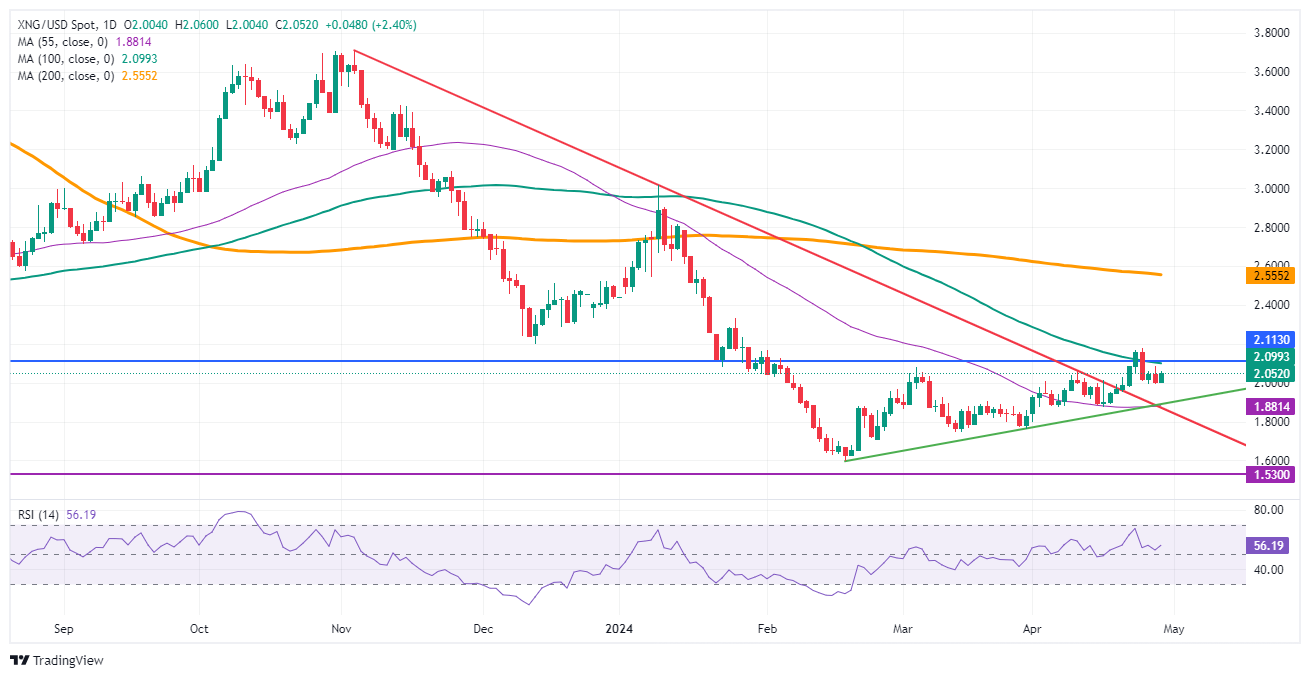- The price of Natural Gas rises, although it seems limited by the decrease in demand.
- Gas prices could fall in the coming days with the arrival of supply from Freeport.
- The US Dollar Index falls following a sharp appreciation of the Japanese Yen unofficially attributed to intervention.
Natural Gas (XNG/USD) prices rise above $2 on Monday, showing a distorted picture of fundamentals versus correlations. Crucially, Gas prices are expected to pull back a bit with news pointing to higher supply and lower demand, a textbook combination that leads to lower prices. On the demand side, Europe is about to face a warm weather front, which will cut gas demand on the continent. In addition, the US Freeport Liquefied Natural Gas (LNG) plant is likely to come online to overcome some of its technical problems, which have hampered production in recent months.
Meanwhile, the US Dollar Index (DXY) is relaxing substantially, helping to push commodity prices higher. The easing is due to an unofficial intervention by Japanese authorities in support of the Japanese Yen (JPY), which has strengthened substantially against the US Dollar overnight. This had a domino effect on the Dollar against other major currencies and pushed commodities higher.
Natural Gas is trading at $2.05 per MMBtu at the time of writing these lines.
Natural Gas News: Relief on both sides
- Bloomberg reports that the Freeport LNG export plant in Texas has restarted one of its production trains, according to raw material operators.
- BP has signed an agreement with Korea Gas Corporation to supply 9.8 million tonnes of LNG over 11 years.
- Natural Gas prices in Europe continue to fall due to the arrival of a warm front for this week and next.
- German Gas reserves remain at 67%, while European reserves stand at 62%.
Technical analysis of Natural Gas: Decline at two speeds
Natural Gas will relax a little with the return to activity of the US Freeport plant, which will add to the US export volumes, which have been tighter in recent weeks. Meanwhile, Europe will see its reserves hold up this week with the arrival of a warm front. This should lead to at least a slight relaxation of Gas prices, which is already occurring in the European Gas market, while the US market needs to catch up.
To the upside, the blue line at $2.11, the 2023 low, and the 100-day SMA at $2.10 are acting as resistance. Further up, the next level to watch is the January 25 high at $2.33.
On the other side, the $2.00 area serves as nearby support. Further down, a trifecta of support forms at $1.88, with the crossing of the ascending and descending trend lines and the 55-day SMA. If this level is broken, expect a quick bearish move to the year's low at $1.60.

Natural Gas: Daily Chart
Frequently asked questions about Natural Gas
What fundamental factors determine the price of Natural Gas?
Supply and demand dynamics are a key factor influencing Natural Gas prices, and in turn are influenced by global economic growth, industrial activity, population growth, production levels and inventories. Climate influences Natural Gas prices because more Gas is used during cold winters and hot summers for heating and cooling. Competition from other energy sources influences prices as consumers may opt for cheaper sources. Geopolitical events, such as the war in Ukraine, also play a role. Government policies related to extraction, transportation and environmental issues also influence prices.
What are the main macroeconomic publications that influence Natural Gas Prices?
The main economic publication that influences Natural Gas prices is the weekly inventory bulletin of the Energy Information Administration (EIA), a US government agency that produces data on the gas market in the United States. The EIA Gas bulletin usually comes out on Thursday at 14:30 GMT, the day after the EIA publishes its weekly Oil bulletin. The economic data of the large consumers of Natural Gas can influence supply and demand, among which China, Germany and Japan stand out. Natural gas is primarily priced and traded in US dollars, so economic releases affecting the US dollar are also factors.
How does the dollar influence Natural Gas prices?
The US dollar is the world's reserve currency and most commodities, including Natural Gas, are quoted and traded in international markets in US dollars. Therefore, the value of the Dollar influences the price of Natural Gas, since if the Dollar strengthens, fewer dollars are needed to buy the same volume of gas (the price falls), and vice versa if the dollar strengthens.
Source: Fx Street
I am Joshua Winder, a senior-level journalist and editor at World Stock Market. I specialize in covering news related to the stock market and economic trends. With more than 8 years of experience in this field, I have become an expert in financial reporting.







